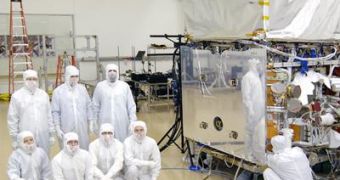The Gamma-ray Large Area Space Telescope, or GLAST is the next telescope built by NASA, designed to explore astrophysical and cosmological phenomena such as active galactic nuclei, pulsars, other high-energy sources, and dark matter.
It will be launched on December 14, 2007, but until then, it's been subjected to various tests in a "clean room" at General Dynamics in Gilbert, Arizona. The workers in the clean room all wear white bunny-like suits to prevent contamination of sensitive electronic components.
In every clean room, there is a maximum number of particles per cubic meter, and air filters continuously purify the atmosphere from pollutants like aerosols (small airborne particles), chemical vapors, dust, and airborne microscopic organisms.
All these precaution measures are designed to make sure the satellite is delivered in the best condition at the time of launch, when it will be carried into space on a Delta-7920H-10C rocket, built by General Dynamics Advanced Information Systems (formerly Spectrum Astro).
"Working in these bunny suits is inconvenient, but necessary," said Steve Ritz, GLAST project scientist at NASA Goddard Space Flight Center, Greenbelt, Md. "With a million channels of electronics and high-tech sensitive instrumentation, we must avoid contamination. Although the cleanliness requirements for GLAST are relatively modest, an unwanted piece of every-day junk in the wrong place could cause a big headache later in the mission. Dust never sleeps."
GLAST will detect individual gamma rays using technology similar to that used in terrestrial particle accelerators, in a range from thousands to hundreds of billions of times more energy than the light visible to the human eye.
Studying these high-energy objects and events could provide scientists with a totally new understanding of our Universe, and reveal things no astronomer has ever seen before, using the existent gamma-ray satellites.

 14 DAY TRIAL //
14 DAY TRIAL //